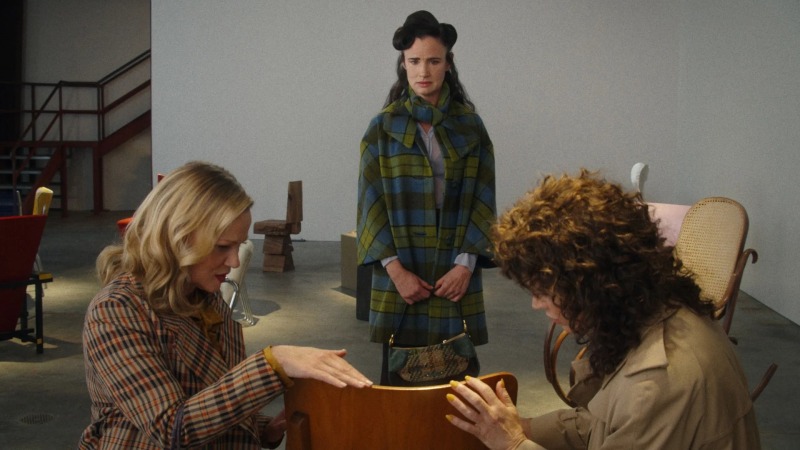Juliette Lewis Is Magically Confounding By Design, Her Soul Trapped in a Chair

One of Sundance’s more buzzy, if baffling debuts this year has oddity oozing from both its pores and its varnished exterior. It’s clear from the moment one hears the premise of In Design that you’re in for something memorably surreal. It’s not every day you see a film that can be summed up as “A woman trades body and soul with a chair.”
The fifth narrative feature of director Amanda Kramer (Please Baby Please) premiered at the festival last month and seems to care little for whether its prototypical audience member can wrap their head around its absurdities. It is content to tell its metaphorically layered story about lonely, dissatisfied humans, the way we perceive each other and internalize aspects of gender and sex, and the way genuine empathy and interest in others tends to remain just outside of our list of priorities. At times, By Design is agonizingly opaque or borderline insufferable in its pretentious indulgences; at other times it’s laugh-out-loud funny as it skewers equally pretentious targets. It casts a brooding, psychosexual spell over its audience, even as its characters drop vocabulary words like “jejune” into their casual conversations with one another.
And it all begins with a really, really attractively designed chair, as stumbled over by Camille (Juliette Lewis) and her lunch pals, Lisa (Samantha Mathis) and Irene (Robin Tunney) as they browse an antique store. Camille, a wounded woman drifting through life and lacking a particularly strong identity, is taken by it instantaneously as some empty part of her rapidly begins to fill up. She envies, as the omniscient narrator (Melanie Griffith) notes, “its beauty, its usefulness, its deserving of praise.” Seeing something so perfectly suited for its purpose rocks her to her core as she compares the relative merit of the chair to that of her own life. “Who needs or appreciates Camielle as much as they do a chair?”, asks the narrator. “She’s never been able to sit there silently and still be seen.” Even her friends are quickly drawn in by its strange, elemental power. The chair awakens things in almost anyone who stops to drink it in.
The subsequent body swap is simultaneously more literal and more symbolic than you’re probably imagining. It is absolutely accurate that Camille swaps consciousnesses with said chair. She inhabits its rigid, strong wooden frame, becoming a passenger within it who thrills at the appreciative way the world now looks at her as a useful, aesthetically pleasing item. Her former physical body, meanwhile, slumps over in disuse, occupied by the consciousness of, well … a chair.
-

-

-

-

-

-

-

-

-

-

-

-

-

-

-

-

-

-

-

-

-

-

-

-

-

-

-

-

-

-

-

-

-

-

-

-

-

-

-

-








































